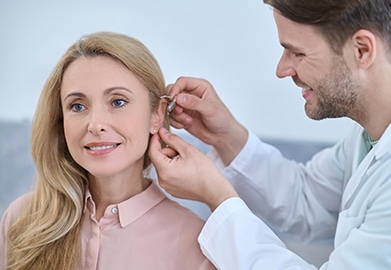What to Expect When Getting Your Hearing Aid Fitted


When it comes time to select your hearing aids, your hearing specialist will work with you to find the best devices for your unique needs.
The selection procedure, known as a hearing aid fitting, begins with an evaluation of your needs and is followed by regular visits to further program the device to suit your specific needs.
Preferences & Expectations
In order to better understand your lifestyle, expectations, personal preferences, and any prior experiences you may have had with hearing aids, your hearing professional must first conduct an extensive consultation. They will then put together some hearing aid options for you to consider based on your answers and the results of your hearing test.
What Your Hearing Specialist Will Want to Know
Your Hearing Test Results
Your hearing test results will serve as a reference for you and your hearing care specialist. The types of hearing aids that might work best for you will depend on the severity of your hearing loss. Your specialist will then provide you with an overview of the types and designs of hearing aids which can be helpful if you’ve never worn one before.
Your Lifestyle Needs
Consider what is important in your day-to-day life and what you hope your new hearing aids can help you do.
More sophisticated digital hearing aids are typically made for users who experience a variety of listening environments with various levels of background noise. Basic models might be advised for sedentary people who spend the majority of their time at home with minimal background noise.
Your Preferences
Your choice of hearing aids can be influenced by a wide range of personal tastes.
Do you like hearing aid devices that are almost invisible, or would you prefer something more visible, so you don’t lose them? Would you rather have computerized devices that change the level of your hearing aids for you, or would you like to manually regulate it?
Your level of physical dexterity may also have an impact on your choices, particularly when considering devices that require battery replacements.
Whether You Have Worn Hearing Aids Before
When choosing a hearing aid, it’s crucial to consider any previous experiences with the devices. If you previously wore hearing aids, it helps to think about whether you enjoyed how they felt, their audio quality, their design, and more. It also helps to consider anything you were dissatisfied with and what new technologies you are interested in.
Should You Get One or Two Hearing Aids
You should have two hearing aids fitted if you have hearing loss in both ears. Hearing with both ears makes it easier to distinguish speech from background noise, improves sound quality, and allows you to determine the direction of the sound. One hearing aid, however, is all you need if you experience hearing loss in just one ear.
Hearing Aid Selection
Your hearing care provider will typically show you a variety of suggested solutions once you’ve discussed your needs with them. After you’ve made your choice, you will schedule an appointment for configuration. If you choose a BTE with earmold style or a custom-fit ITE style, your hearing care specialist will take an impression of your ear canal as well.
Initial Hearing Aid Programming
The hearing care specialist will connect your hearing aid to the computer and calibrate it based on your hearing loss and preferences. Some specialists may program prior to your appointment, while others prefer to do it in your presence. To confirm that the amplification levels are accurate, many clinics will also conduct real ear measurements.
The fitting may require numerous consultations if you have complex hearing loss, such as asymmetrical hearing loss, in order to achieve the ideal sound quality. This is particularly true if you need assistance in creating programs for customized sound settings for various circumstances.
Adjusting to Hearing Aids Takes Time
You’ll start to hear a variety of sounds you haven’t heard in a while once you begin wearing your hearing devices and may initially think that everything is too noisy. Your brain will need time to retrain itself to ignore some of the background sounds.
Some people acclimatize to using the devices in just a day or two, but most people take several weeks to many months. The most crucial thing to keep in mind is to wear them, even if it’s just for a little while. Starting slowly and building up each day will help you become comfortable enough to wear them all day long.
Adding Custom Hearing Aid Settings
The default setting of many hearing devices is geared toward capturing speech in quiet settings. However, sound is far more complicated, especially if you play music or work in a noisy environment. Fortunately, you can add personalized hearing aid settings with the help of your hearing care professional.
We Recommend the Best Hearing Aid After Assessing Your Needs
At Bravo Hearing Centre, we have the best hearing care specialists and offer various hearing aids for different types of hearing loss. We are a leading provider of hearing services, including counselling and advice for better living. Visit our website or call us at 416-207-9711 to book an appointment or to learn more.

